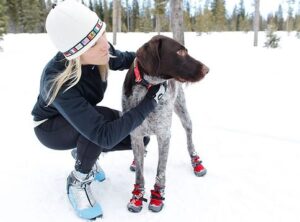
1) Trim long hair – If your dog has longer hair between his toes, make sure it is trimmed shorter to minimise the snow and ice that can build up and cause pain and irritation.
2) De-Icer – Be aware of the strong chemicals that can be used to de-ice roads or paths in the snowy weather as it can be harmful to your dog’s paws. The strong chemicals can be an irritant to the pad skin, and could also be harmful for your dog to ingest if they lick it off their paws. Make sure you clean their paws thoroughly after a walk
3) Towel-Dry – Take a clean dry towel with you on a walk, so you can wipe dry irritated paws as you go
4) Keep the Paws Clean – After each dog walk, wash and towel dry your dog’s paws, paying particular attention remove any ice, snow or grit from between their toes.
5) Moisturise – After you have washed and dried your dog’s paws, rub in a little moisturiser into the pads if they are chapped. Although, don’t use any perfumed or alcohol based products, nappy rash cream is very effective.
6) Petroleum Jelly – Massaging your dog’s paws with petroleum jelly before taking them out on a dog walk will seal in moisture and also protect them from the extreme cold, grit and harsh chemicals.
7) Booties – if the weather is really extreme and your dog is suffering, you might want to invest in some booties before you head out in the snow. They offer great protection and warmth for snowy paws and will minimise your dog’s contact with de-icing chemicals too.

